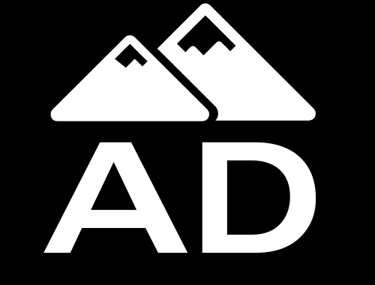Jesus Sends Them Two x Two
Written By: AD Faith Team (Orthodox Christian)
The issue of going out two by two is often understated in many different religious teachings when discussing the gospel of when Jesus sends them out two by two. There are three key points to every parable, action, or story that God is trying to relay, and I'll utilize this story as a representation of that. Firstly, with the appearance of Elijah and Moses on the mount and the two angels in the tomb, the appearance of God the Trinity is evident in every instance where God the Father and the Holy Spirit are also enacting an absolute plan or an absolute truth.
The Father and the Holy Spirit are identified in two other beings in the presence of Jesus, made to represent that everything Jesus does, He does so with the HS and the Father present as well. What does this mean? The meaning and purpose of the absolutism surrounding the appearance of the Trinity in three formats, physical and spiritual, in the written gospel is to assign several things: the first being the teaching of Jesus, the second being the core identity of the purpose for the Holy Spirit, thirdly for God the Father, the Godhead. Now, the interesting thing is, God, the Godhead, is the one who institutes knowledge, as can be seen from Jesus saying, you would not have known these things unless my Father had granted it to you, when He's speaking to Peter, or when He's speaking to the rich man, he says, you are not far from the kingdom of heaven, and He relates to him the side of the story which is specifically understanding what the covenant and the most important commandments with God the Father are.
In these two instances, He relays this in the parable of the prodigal son. He also relays that the Father is the one who is providing information and instruction when He discusses a father and two sons. Once again, we see a figure of the Trinity; the three pops up again, but we also see that the Father is the one who is proclaiming things. Thus, Jesus, the Son, in physical form, is still representing the Trinity in its actual physical presence in His teachings and in the eternal and spiritual meanings of what He is saying. With the Father saying, my son, we had to be glad because this brother of yours was dead and is now alive, he’s lost and now found, He is telling people the reality of living in sin and a state of sin, but He’s also showing that the Father is the one who is providing this insight and that it is absolute and beyond reproach, and not just for an understanding of the deeper meaning, but also to show how Jesus is only relaying information to human beings that is already approved for distribution by the Father.
How do we ensure or understand that it is already the Father’s say-so? It’s because of when Jesus is discussing things and says, I thank You, Father, for revealing these things to these little children and not to these learned men. The Father is allowing the Spirit to reveal things to the children; that is the Father allowing the Holy Spirit to reveal things to little children and the Son to recognize the Father’s authority in the distribution of the information that’s being provided. The interesting thing is, there is a reason why Jesus sends them out two by two, but it is always going to be a tri-reason when He gives a command or when there is an absolutism event within the gospel.
As we reflect on the mountain experience, the characterizations of the Father and the Holy Spirit through Elijah, who was taken up by fire, and Moses, the custodian of the covenant that reveals the face of God to Israel, serve to illuminate Jesus as the fulfiller of the covenant. He embodies humanity and represents the eternal, life-giving water, a symbol for the Spirit. Consequently, while Jesus is present, the physical manifestations of the Father and the Holy Spirit are also evident on the mount and within the tomb, as illustrated by Mary’s encounter with the two figures,one positioned at the head and the other at the foot. The figure initially regarded as the gardener addresses her by name, guiding her to realize that it is indeed God, the Lord, the Christ, Jesus, her master, Rabboni.
A compelling aspect of this narrative is the imperative to comprehend that when Jesus issues commands, they inherently encapsulate a triadic core message. Each member of the Trinity must be represented in every directive imparted. While we may explore this in greater depth on another occasion, for our current discussion, we will concentrate on the notion of two by two. Within this framework, there exist three fundamental elements that coexist in pairs. Primarily, Jesus asserts that wherever two or more are gathered in His name, specifically referring to His name and not that of God the Father or the Holy Spirit, His presence is also among them. This implies that Jesus desires them to replicate what transpired on the mount and in the tomb, with representations of the Father and the Holy Spirit manifested through the angels, one at the head and one at the feet, analogous to the depictions of Elijah and Moses, encompassing both fire and the covenant giver.
In this context, Jesus emphasizes the urgent need for the manifestation of the Trinity during moments of revelation or communication. Mary is the first to encounter the gardener in Jesus’ absence, followed by Jesus Himself, who has prepared a place for her. A profoundly beautiful aspect of Mary’s encounter at the tomb is the fulfillment of Christ’s teachings, specifically that Christ does not supplant our existence as a vanquished body. We occupy that space, having been made ready by Jesus, who has already risen. Thus, the tomb symbolizes more than mere resurrection; it encapsulates the profound truth that God the Father and the Holy Spirit acknowledge that your place after death has been prepared by the One who has triumphed over death, namely, the one who stands outside the tomb.
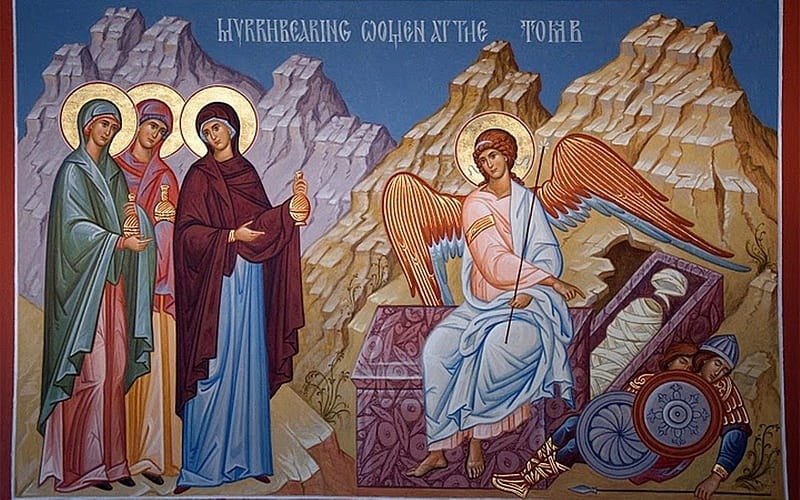

In the narrative surrounding Mary, we observe the profound representation of absolute salvation through the imagery of an empty tomb and a position between the Father and the Holy Spirit. The scene presented at the tomb of our Lord indicates a physical reality where she witnesses the textual evidence of our prepared place beyond death. This is the first physical image of what is prepared by the one who sacrificed himself. Mary enters and perceives the place that Jesus has arranged for her between the Father and the Holy Spirit, symbolized by two angels. Additionally, the Holy Spirit is notably characterized as tongues of fire during the Pentecost, which is indicative of the divine potency carried forth in the Word, executed by the Holy Spirit, the essence of life, represented through fire and water.
Moreover, we witness the waters that once cleansed the earth and the covenant established with God to refrain from such acts again with Noah. The Holy Spirit, thus, plays a role in purifying individuals through fire. The representation of Elijah emerges significantly as the covenant and its fulfillment approach. Fire symbolizes cleansing, an elemental necessity for what would otherwise lead to eternal damnation had the Son not come. This imagery is embodied in Elijah, who dismantles false idols and their followers. The law is, in turn, personified by the Father through Moses, who reflects the divine. The transfiguration of Moses atop the mountain also serves as a profound illustration of the representation of the Father and the Holy Spirit in their elemental, spiritual, eternal, and legal dimensions, signifying the culmination of the law through the power of the Holy Spirit.
At this juncture, we recognize the presence of the Father in Exodus and the Holy Spirit through Elijah and Elisha, who foreshadow the fulfillment of God’s covenant in what is to be realized through Jesus. They are manifested in a transfigured state, represented by the holy angels present to honor the accomplishments of the Father, the Holy Spirit, and Jesus. Hence, prior to death, we witness the convergence of those bound to the covenant of death, alongside the initiation of the passion, intertwined with the fulfillment of the covenant encompassing Abraham, Isaac, Jacob, Noah, and all who are descended from David, leading us to the transfigured version of reality.
Intentionally, this moment grants a profound visual perspective on the afterlife. Before Jesus' exodus and death, we observe two human figures symbolizing the law as embodied by Moses, who intended to guide his people toward liberation through Jesus. We also see the Holy Spirit represented as the life-giving elements of fire and water. Jesus articulates, "I go now, and the Holy Spirit will come," as the Holy Spirit epitomizes eternal life, the essence of the water present. Mary is the identified figure in the gospel context, highlighted by Jesus in response to John and James’s inquiries regarding positions of honor in heaven, where he reveals that those who appear last will be first. The final decision rests with God the Father; it is not contingent on Jesus’s death or the authority bestowed upon him post-mortem, which encompasses absolute power.
Fast forward to right before The Passion & we find ourselves encountering Mary Magdalene, the first to anoint God's chosen with oil, embodying the paradox of exaltation through humility. She honored Christ through a pure act of devotion prior to his final moments in mortality. She epitomizes the respect afforded to the King, and the Father blesses her by assigning a place of honor where the narrative intersects with the acknowledgment of her promised position. Post passion, as Mary M approaches the tomb, she perceives her designated place amid divine representatives of eternity (i.e the two angels). This moment transcends mere imagery; it signifies the fulfillment of the promise. Behind her stands Jesus, who has prepared this space for her in the empty tomb. The act of humbling oneself, symbolized by her using her hair, reflects her recognition of her own creation's sacredness, a profound statement of her redemption even amidst her perceived sinfulness, suggesting that she need not be redeemed in a conventional sense.
This sentiment encompasses immense significance. Jesus' mother Mary, the second individual named in the gospel, embodies the archetype of Eve, being a mother to all. However, Eve signifies the fallen state of human existence. In contrast to this, we are given the sinless Mary, who bore Christ through the will of the Father; this representation serves as a reminder of human capacity to do carry out God's will.
With Mary Magdalene, the symbolic act of unveiling was to put her most symbolically valued aspect (her hair, representative of her ability to reproduce), beneath Jesus's feet. That act underscores her acknowledgment of our creation from dust, simultaneously recognizing her own mortality in the presence of the immaculate God (Jesus). In doing so, she illustrates a humbling, surrendering herself and her agency in the creation narrative. She brings what is required to Jesus, everything she owns in a bottle of oil, and pours it out. She is the first to follow Jesus' command to go and sell everything she owns, and takes it a step further. Mary does not buy the oil and keep some after as a valued thing; she empties everything to show complete submission of her earthly worth, offered up physically to God.
Thus, she anoints Jesus not only as an act of obedience to the Father and through the empowering presence of the Holy Spirit; she simultaneously conveys her recognition of her state of subjection to eternal death without Christ. In that moment, Mary has nothing of worth societally but the approval of Jesus via His love. By situating herself in this manner, embodying every individual’s fallen nature, she submits to the divine authority and representation of a life initiated by the Father. Additionally, she returns to God what is God's, her ability to obey the first command "go forth and be fruitful and multiply, " recognizing her identity as dust without Jesus' feet to cling to. In this way, she signifies her acceptance of her fallen state, entreating redemption to bring forth new life from her otherwise lifeless existence.
Ultimately, her posture positions her as the quintessential individual who is 'last', because she has lowered her social standing to below a servant in the presence of the men in the room. Paradoxically this results in Mary becoming the first to perceive her designated place in Heaven, at the tomb. Jesus (the gardener) acknowledges her created identity by calling her "woman" and subsequently naming her, conveying a recognition of her dual nature: as a fallen mortal, yet simultaneously granting her eternal significance as the first recorded saved after His death. Upon being recognized, she physically observes her divine place in the ever-unfolding narrative of time and judgment. The beauty of this interaction lies in the revelation of our relationship with the divine; it underscores a profound moment wherein Christ remains behind her, representative of the promise of grace during our divine evaluation.
Similarly, the doves appear when Jesus is baptized, representing an official act of purification and acceptance into the family of Christ. Rather than two doves at the moment of baptism, we observe a single dove, alongside the voice of the Holy Father, manifesting the will of the Father through John the Baptist. This singular dove suffices because the Holy Spirit is present in that moment, as it was with Noah when the two doves were sent forth from the ark, symbolically cleansing the earth and enabling life to flourish. Two doves for Noah, as was with the command of how many to take with him to preserve life on earth (foreshadowing anyone?). We witness the return of the dove at a pivotal moment when life is liberated from sin, embodied in Jesus. Hence, the sanctification of the earth is an intrinsic right and responsibility of the Holy Spirit. In this context, the Holy Spirit is emblematic in the transfigured Christ, prepared for us in the tomb, by the one who stands at His feet.
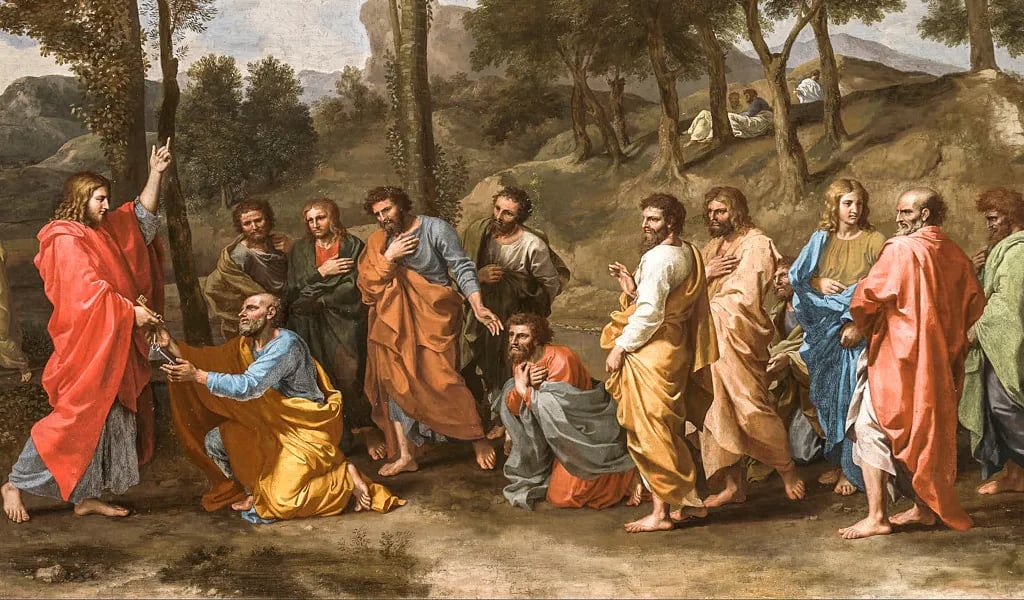

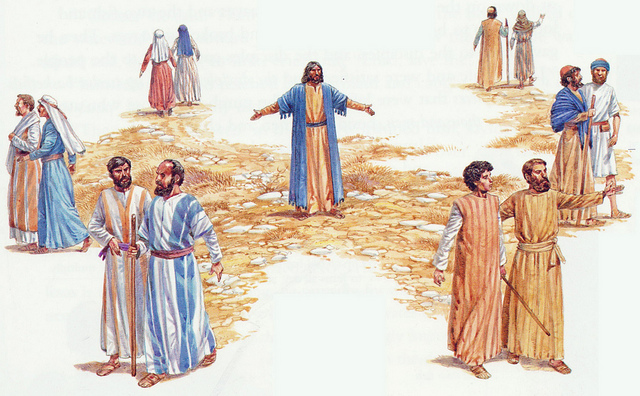

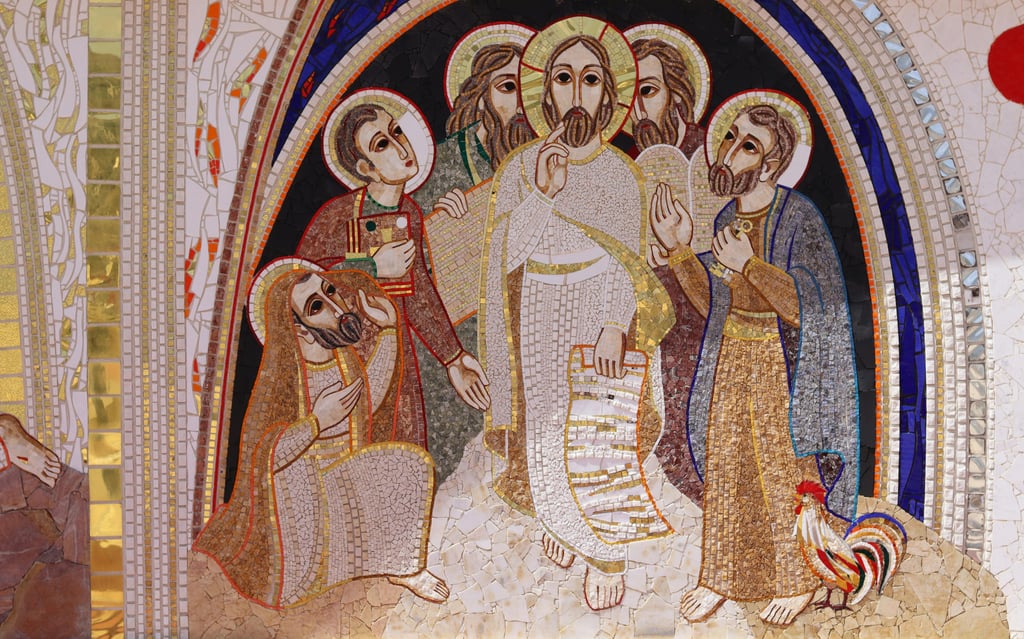

When the command is given to Jesus to retreat in the wilderness, it signifies the necessity of maintaining a distinct separation between the Father and Jesus. At that moment, Jesus is physically engaged in the forty days of preparation, an experience we may explore in greater depth later. His directive, "Get behind me, Satan," establishes him as a Son to the Father, thereby nullifying the intermediary role that Satan has attempted to assume. Jesus commands Satan to return to his fallen state, a fate that ultimately consigns him to eternal damnation upon the Earth, hence the imperative for him to assume a position behind. This dynamic is reflected in the context of the Son standing behind Mary, while she represents humanity before the Father and the Holy Spirit, embodied by the two angels, without a third party to judge her. It is here that the statement, "Then neither do I condemn you," resonates profoundly. Jesus will separate you from the fallen and be the grace at your back when in front of the Divine Judge and Master, The Father.
Mary approaches the grave, symbolic of all human mortality and frailty. The gardener recognizes her, prompting her to remember the garden's significance both as a woman and a human being. Upon his calling her name, she is metaphorically embraced by Jesus, as one of His own flock/family. The shepherd's presence indicates that her path forward into the divine space is intentional. He has prepared that spot for her. and for all of us. This space is representative of conquering death, and it positions us amidst the Father and the Holy Spirit. In essence, we are now part of the family; the prodigal daughter and son are endowed with this particular place, which is visibly acknowledged. Consequently, we are endowed with immediate and absolute understanding, as the presence of the Trinity affirms the law eternal, a saved people, a child welcomed home.
The space created by Jesus for humanity is not only prepared but also distinctively vacated by Him as He serves our salvation. He emphasizes this by stating, "I go to create a place for you in my Father’s house in heaven," which denotes His intention to inform the Father about this newly established space that Mary beholds. Notably, this occurs in the presence of the untransfigured Christ, demonstrating that He remains untouchable in that instant, the implication being that He has not yet ascended to the Father. Thus, this absent space symbolizes the preparation that has been made for us, even though Christ has triumphed over death and risen, having made the ultimate sacrifice. It is vital that we comprehend that He has not yet been wholly transfigured, as He had not yet encountered the Father after His death, while others, later in the Gospel, were able to physically engage with Him and witness His wounds and signs of suffering. Mary, by the grace of God, is the First to witness the conquering Jesus, an eternal honor. The last, is made first, and by the direct will of The Father.
What unfolds in that moment is deeply beautiful and significant; we witness Jesus reassuring us that even the most sinful among us can find a place that He has prepared, which He has communicated to the Father. This absence is meaningful as it represents the reality of His not yet having returned to the Father, reinforcing that Mary still possesses her designated place since He stands behind her. Hence, despite His death and resurrection, He once again represents the resurrection narrative, exemplifying our salvation. While He has died for humanity, we live through Him in that designated space, a notion underscored by the authority given to Him by the Father, enabling Him to assign the last of us, a representative who is not condemned by Jesus, standing behind her as a servant intent on facilitating her return to the heavenly kingdom. Amen.
Reflecting on the symbolism of the two signifies deeper meanings.
In the transfiguration on the mount, two significant figures, Moses and Elijah, are present. Similarly, in the resurrected tomb, there are two angels. The dual representation of the Father and the Holy Spirit can also be observed through John and the dove. The dove serves as a poignant reminder of the biblical narrative where it returned to Noah carrying two olive branches, signifying life after the deluge. As such, the Holy Spirit stands as the spiritual life-giver, echoing this paired representation that accompanied Noah following the destruction wrought by the waters. This resonates as a pivotal moment, a law that underscores the moment when humanity faced destruction while the earth was cleansed. The Holy Spirit arrives, fulfilling the divine will of the Father in concert with the Son of Man, which ultimately foreshadows the revelation of Jesus Himself.
As we observed, this connects back to the concept of two by two, where two feet and one mouth emerge. There are two entities that serve as means alongside one that represents the witness. When two individuals move together, Christ's presence is assured. They are engaged in the act of walking, traveling to share the message across the globe, fulfilling the mission of making disciples of all nations. He states that should you be welcomed, you have a singular path of choices available; however, if not welcomed, you must shake the dust off your sandals. I.E They are dust, so return them to the fallen earth and separate them from your eternal self. Cleanse yourself from the fallen, dead earth; its elemental makeup is so dead that it is not fit to be on the bottom of your sandals. Heavy stuff.


Written By: Gabriel Merigian In Association With AD News Faith
AD news Editorial Team collaborates on stories in-house and with external reporters to bring you exclusive pieces, like this one.
An Examination of the Significance of Baptism:
Consider the significance of John the Baptist’s proclamation regarding the Messiah, wherein he states, "It is He who, coming after me, is preferred before me, whose sandal strap I am not worthy to loose.” (NKJV).
To further comprehend the essence of this expression, it is essential to grasp the context of Jewish Law during that period. The authority within Jewish Law is conferred by God upon individuals, and the lineage of that authority is perpetuated over time.
Moreover, John the Baptist's role in the Gospel illustrates the importance of Jesus' baptism as the initial act of His anointing.
(It is noteworthy that this concept forms a foundational argument for the legitimacy of Judeo-Christian Kings and their hereditary lines throughout antiquity and the medieval ages. A distorted interpretation emerged in which society was led to believe in the "Divine Right to Rule," a notion propagated by ecclesiastical reference by religious authorities who usurped their authority to claim societal governance, distorting property ownership until the advent of individual property rights heralded by the Magna Carta, thereby establishing a pivotal position within the House of David lineage of Kings.)
Baptism, in contemporary society, is often severely misunderstood. The context surrounding John’s baptism is rarely addressed within Protestant or even Roman Catholic churches, as they have diverged significantly from the central apostolic teachings, the foundational community established by twelve Jewish disciples, chosen by the Jewish Messiah from the lineage of Abraham and King David.
This disconnection is a matter of concern, often attributed to ineffective leadership. Due to this failure in leadership, the true meaning and context of the Holy Sacraments (Baptism, Confirmation, Communion, Confession, Marriage, Ordination) have been obscured, leaving interpretation in the hands of individuals who may not possess the divinely granted authority, having not adhered to the established lineage of authority as exemplified by John and Christ.
The concept of the "laying on of hands" also has its roots in this understanding. The blessing of lineage and authority was exemplified by Isaac, who set a precedent in Genesis 27 with Jacob. Despite being deceived, Isaac recognized the sanctity of the authority being conferred, acknowledging it as divinely ordained and legitimate, irrespective of his (Isaac's) intentions.
Note: This is a lengthy discussion; feel free to skip to the continuation and then return to assimilate the discussion after completing the reading.
Continuing:
True authority to admit individuals into the Tribe of Abraham must be conferred directly by God. This is evident in the passage from Genesis 17:13, where God asserts, "He who is born in your house and he who is bought with your money must be circumcised, and My covenant shall be in your flesh for an everlasting covenant." (NKJV)
John’s baptism of Gentiles utilized water as God’s chosen method for cleansing the fallen earth, positioning it instead as a means of salvation. Individuals associated with the fallen, not through David's lineage or the Law of Moses, acknowledged their state, condemning the earth outside the Ark (the physical vessel) and the Will of the Father, i.e., the Covenant (Noah Covenant + Law of Moses + Abraham Covenant + Davidic Covenant), ultimately cleansing themselves of that tribal heritage.
Emerging from the water signifies a physical entrance into a new covenant with Noah and subsequently with the house of David for the Gentiles.
This baptism was a non-violent, pain-free initiation into an ethnic and religious community that claims authority over entry into the lineage awaiting the arrival of the Messiah, symbolized as the Living Water.
John, a Jewish Prophet, was respected by his contemporaries for disseminating Torah among Gentiles. Many considered him the prophesied Messiah, as this was one of the primary roles anticipated of that figure.
Nevertheless, John clarified that he was not the Messiah, but rather the one preparing "The Way." He indicated that the True Messiah would not baptize with water but with the Holy Spirit. This suggests that the coming Messiah will have the Authority of God to impart the Holy Spirit; hence, the true Messiah is not solely a son of Man (Adam) and David (the Covenant), but also a Son of God, possessing divine Authority. Under Jewish Law, this signifies that the Father must be Divine in Nature, although the Mother could be human.
Jesus was presented at the temple on the eighth day by Mary and Joseph, thereby being consecrated within His ethnic lineage before His Baptism.
Jesus’ involvement in baptism conferred authority, aligning with what is acceptable and pleasing to God.
Thus, the voice of the Godhead (Father) affirms His pleasure during the Baptism, while the Holy Spirit blesses this act as well through It's descending physically to be present represented in the form of a Dove.
This symbolizes the presence of the Dove (the Olive Bearing Animal to Noah, representing the earth's new covenant with God, pledging never again to destroy it by water) through the Anointing by Olive Oil of God's Chosen King, David, the lineage of the Prince of Peace (hence, the Olive Branch serves as the most widely recognized global symbol for a "Peace Offering"). It is at this moment that most Christians receive a white article of clothing, representing their wedding garment washed clean by their baptism.
Orthodox Christian Note:
Reasoning for all three sacraments during Baptism of an Infant:
Jesus indicated that we will be judged by the fruits of our actions.
Jesus frequently referred to Himself as the "Vine Branch".
The fruit from the Branch of Peace Delivered is Holy Olive Oil. The Fruit of the Vine is represented by the wedding drink, Wine.
The wedding feast symbolizes the eternal bread of life, Communion.
In the baptismal rites of the Orthodox Apostolic Churches, we anoint with Olive oil immersed in water poured from a dove. This baptism constitutes your Ethnic and Spiritual Authority and Heritage within the Family of Christ, linked to the Line of David, and the Lion of Judah.
Upon baptism and entry into the family, the child receives a wedding tunic (a small white garment) and is immediately welcomed at the wedding feast (bread soaked in wine), the Sacrament of Communion.
For the he spiritual battle enablement lesson tied to an application of this story click HERE
Writer's Note: In this section, readers may begin to understand the societal stereotypes and their genuine origins. Jokes about Jewish individuals being adept lawyers stem from their identity as the people of the Law of Moses. A Jewish person's religious life is profoundly intertwined with adherence to the laws laid out by God. This understanding is a reflection of their ethnic heritage and divine obligation to be good stewards of the Law. It is poignant that society often views this commitment as a negative stereotype, which internally reinforces a narrative of fallen nature among those who harbor animosity towards them. This notion fore Jewish people can then be received and, for instance, can evolve into thoughts like, "They oppose me because they resist God’s Law, which exists as a consequence of their fallen state. Thus, it is imperative that I safeguard my community against such fallacies while upholding God’s Law," leading to a breakdown in communication between communities during pivotal moments in history. Such misunderstandings can cloud the recognition that it was God's Mercy that delivered the Israelites from Egyptian bondage, not merely their adherence to the law. In retrospect, Jesus embodies the law itself. A failure to recognize the Law of Moses' foundation, comprised of Mercy, Grace, and Love. has led to an overemphasis on the Law alone, overshadowing the central figure who brought these attributes to life for their ultimate return (the Messiah). As baptized believers, we too must remember this connection; the Jewish people are part of our extended family, deserving of the same Love and Mercy that God afforded to them in their times of adversity, just as He did for us amid our own transgressions, recognizing that their faithfulness paved the way for our inclusion within this divine lineage.
Life-giving water has entered the chat, for all of world history now.
When Jesus ascends, He indicates that His departure enables the Holy Spirit to come.
If the Light of the world is departing, how do we carry it forth into the world?
The Answer: Internally.
Jesus’s baptism illustrated that it is through His authority that we receive the Holy Spirit in our own baptisms, thereby integrating us as full physical and Spiritual members of God’s divine and eternal family. We engage in this eternal covenant, similarly to how Noah carried God's plan for our eternal Life within the Ark, bringing forth the Light unto our paths. This concept is further validated by the figure of Elijah on Fire upon the mount, as Jesus was about to embark on the fulfillment of THE Exodus on the Cross. Additionally, an Angel is represented at the location of Jesus' body in the tomb.
This serves as a guiding principle, illuminating our path, epitomized by the Holy Spirit—the lamp and fire-giver.
Two By Two Now Made Clear:
When you proceed two by two, you act in the place of the two Angels in the tomb.
Your light extends throughout the world, facilitating your departure from a fallen and condemned state, as you align with one who is seated next to you, positioned before the Father and the Holy Spirit, at the feet, designating your separation not only from the earth and its dust but also from the condemned eternity, recognizing that dust shall be purified and returned to ash, its make up of elemental matter.
In this context, the guidance provided by the Holy Spirit acts as a shield against the fire. This observation holds remarkable prophetic significance. One individual, situated in a specific location, possesses a mere mention that encapsulates the entirety of their presence, even as attention is directed toward the broader moment. Yet, the fullness of the Holy Spirit is succinctly articulated within a moment, accompanying the Father in the same sentence, often overlooked by the wider world regarding the importance of these roles.
It is now our responsibility to proceed as two doves carrying an Olive branch (a Symbol of Peace on earth to Noah from God) into the world.
We are tasked with sharing "The Good News (Avedis in Armenian)", proclaiming that we are all invited to the wedding table and called by the Bridegroom to the feast.
Contemplate this notion deeply:
Our feet are illuminated for the journey ahead, representing the bearer of light, which is indeed the light of Christ, facilitated through the Holy Spirit that guides our path, allowing us to navigate through a fallen world.
Jesus sent the apostles two by two because "Where two or more are present in My Name, there I AM present as well.
This is the official "I AM", not merely as Jesus asserting His presence with you, but reflecting the WILL OF GOD THE TRINITY being present and correcting a fallen world.
"I AM" is encapsulated in the Burning Bush, which signifies the commencement of God's actions towards the Exodus. Notice that "I AM" instructs Moses to remove his sandals, as the ground upon which he stands is "Holy Ground."?
The purifying fire (Holy Spirit) acts in accordance with the will of the Father for the salvation of I AM's people.
Two individuals move forward with the will of The Father and the Fire of the Holy Spirit, witnessing for those in exile, bringing bearing the Light of the World. Consequently, the ground is purified, and the one in exile is instructed to discard his sandals and tread upon holy ground.
Now the implications of Jesus' teachings are made clearer:
Writer's Note: The white flag is a global symbol for surrender, representing the ultimate submission to God through the blood of Jesus, rendering our attire free of worldly stains (i.e., White Tunic, a portion of which was torn and presented as a sign of surrender to Peace under the authority bestowed upon the Prince of Peace by God, which both parties recognized and respected). Most credible scholars, even those who begrudgingly acknowledge the alignment with Christianity and suggest it could be any number of other factors, will admit that this concept originated in the first century AD. This concept is irrefutably evident and serves as additional evidence of Christ as the Messiah, as the entire world now legally acknowledges this symbol of surrender and peace. (Though some may reference a post-Jesus account by a Roman author, claiming the Carthaginians signaled a desire for peace utilizing white wool and olive branches at a surrender in 201 BC, it is rather convenient that such assertions arose from a Roman historian who often appropriated cultural advancements as their own.)
Jesus informs us that we shall witness the earth itself corrected, and dust will no longer be lifeless where "I AM" is Present. Exodus as begun, the Will of the Father is at work!
Wherever two or more of you gather, there "I AM" is also present. Thus, your physical and spiritual beings must act out the will of The Father post interaction as well, so that you continue in alignment with I Am.
A fun note on this is that it is also physical evangelization by simply the two of us being present. We simultaneously provide witness & provide evidence that the Trinity comprises three distinct beings in one, represented in physical form only when there are three present: Two Humans and God in the form of two obedient to the will of The Father.
When you go forth, preparing the way of the Lord:
Proceed as the two angels, one at the head and one at the feet of the tomb, to escort the lost lamb back to its place of honor and family beyond death, as witnessed by Mary Magdalene at the moment she encountered the triumphant Jesus.
Jesus’s Final Command was for us to go forth into all the world, baptizing (Welcoming into the family) and making disciples (teaching Torah) among all nations. Through this act, we affirm Jesus as the Christ, as we obediently work as two to bring salvation to one lost lamb at a time.
The Doxology:
One of my favorite moments during mass and church celebrations is known as "The Doxology", sung collectively by the congregation and choir. It is fascinating because it showcases the love of all cultures and people praising their adoption into the family of the King. It creates a shared global praise, allowing all of creation to acknowledge God as Our God.
However, the Doxology is expressed through musical tones, with words distinct to various peoples, emphasizing that we are not indistinguishable, but rather uniquely crafted in the image of the God whom we praise.
Doxology Words:
Praised be God, from whom all good things flow.
Praise be to God, all creatures here below.
Praise Him above, ye heavenly hosts!
Praise Father, Son, and Holy Ghost!
We witness the above, the below, and those who remain in the tomb.
This extends into our lives and into what is to come beyond death.
In Closing:
The directive of going forward two by two signifies not just a mere command, but something far more profound than initially perceived, as it mirrors those definitive moments of God's will, in moments when Christ, the Father, and the Holy Spirit serve to guide us. In this context, moving forward as two endeavors to recognize the third. Three-in-one.
We, whether two or more, advance with Christ, thereby representing the true triune God: the Father, the Son, and the Holy Spirit, united as one God. Amen. God bless you and enjoy the rest of your day.
Scenario A:
One accepts the word of God and serves as God's instrument for the Exodus of the enslaved. Bless the house (Provide your authority from the House of David and Abraham to the house and proceed)
Scenario B:
One receives the word and negates its significance. Ground is dead, so return that dust to the earth.

